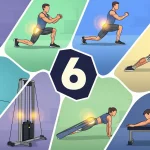Have you ever twisted your ankle unexpectedly while running or climbing stairs? Or felt your legs get tired quickly even after just a short walk?
Think about it. When was the last time you seriously trained your calf muscles? Maybe never?
If that is the case, you are not alone. Calf training, or calf raises, is often overlooked by many people, including you and me. Yet, your calf muscles play a huge role in maintaining stability, leg strength, and sports performance.
Let’s explore what calf raises are, why they are important, and how you can maximize their benefits so you are not just moving up and down without purpose.
What Are Calf Raises?
Calf raises are a movement where you stand and lift your heels so your body weight rests on the balls of your feet. Even though it looks simple, this exercise activates two major calf muscles: the gastrocnemius and the soleus.
You can do this exercise anywhere. It can be done at the gym, at home, or even while waiting for a reply from someone you have been texting. The benefits are far from a joke.
Benefits of Calf Raises for Daily Activities
This exercise is not just for athletes. Office workers, people who frequently climb stairs, and even those who simply walk regularly also need strong calf muscles.
- Lower body stability and balance – Calves help maintain posture when standing, walking, or changing direction suddenly.
- Improved running and sports performance – Strong calves make each push-off step more efficient.
- Better blood circulation in the legs – Useful for those who sit or stand for long periods.
- Injury prevention such as ankle sprains and shin splints – Calves act as natural shock absorbers.
According to the Journal of Sports Rehabilitation (2020) and the American Council on Exercise (ACE), consistent calf training can reduce the risk of injury by up to 50 percent in runners and recreational athletes.
Types of Calf Raises You Can Try
Calf raises are not limited to one version. You can choose variations depending on your equipment and goals.
- Standing Calf Raises (two legs) – The most basic version and suitable for beginners.
- Single-Leg Calf Raises – Improves balance and deeper muscle activation.
- Seated Calf Raises – Focuses on the soleus muscle and adds variety to your training.
- Donkey Calf Raises – Higher intensity and suitable for advanced exercisers.
- Weighted Calf Raises – Use dumbbells or a barbell for more challenge.
Tips for Doing Calf Raises Correctly
A simple movement still needs proper technique. Here are some tips:
- Move with control and avoid bouncing too quickly.
- Hold at the top position for 1 to 2 seconds to maximize contraction.
- Use the full range of motion so the muscles work optimally.
- Train barefoot or with minimal padding shoes for a more natural feel.
Recommended Calf Raise Training Program
You can include calf raises at the end of your leg day or during active rest days.
- Frequency: 2 to 3 times a week
- Volume: 3 to 4 sets of 12 to 20 repetitions
- Variation: Rotate different variations each week to keep progressing
Can Calf Raises Make Your Calves Bigger?
Yes, but it depends on genetics.
Calf muscles are dominated by type 1 (slow-twitch) fibers, which means they need higher repetitions and larger volume to grow.
Do not focus only on size. Prioritize function so you can move, walk, and run without fear of injury. The shape of the muscle is a bonus.
Conclusion: Real Strength Often Comes from Small Things
Calves may look small, but their role is significant. Calf raises may look simple, but the impact can be felt in your balance, sports performance, and overall leg strength.
At Focus Fit, you can try various calf raise variations with complete equipment and guidance from professional trainers. For us, #StayFocs is not only about appearance but also about function and consistency.
Start small. Start now.





